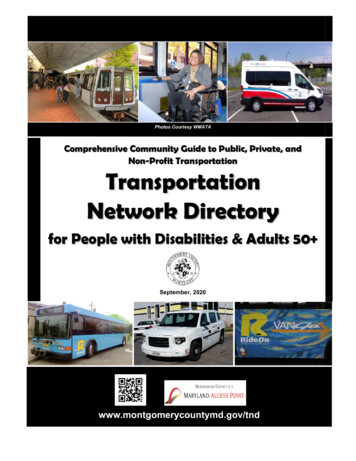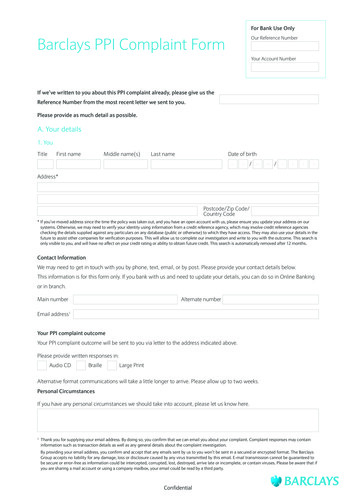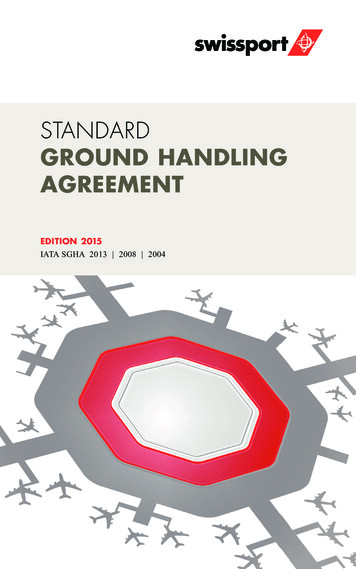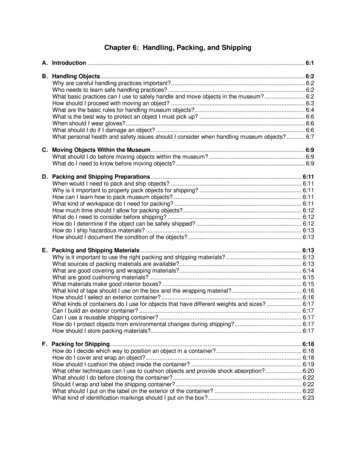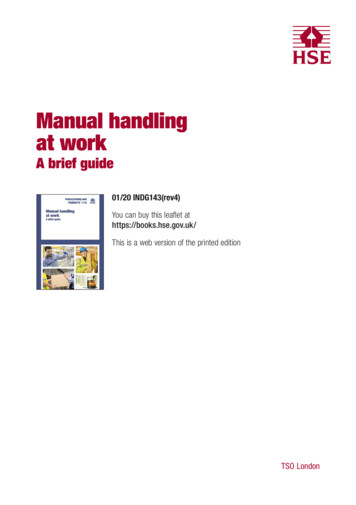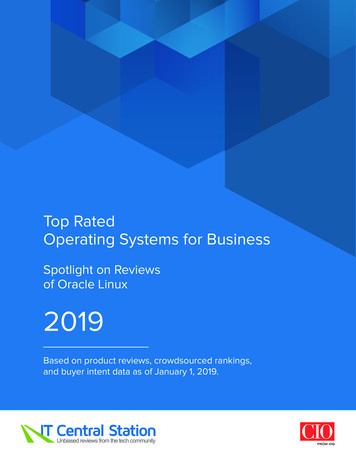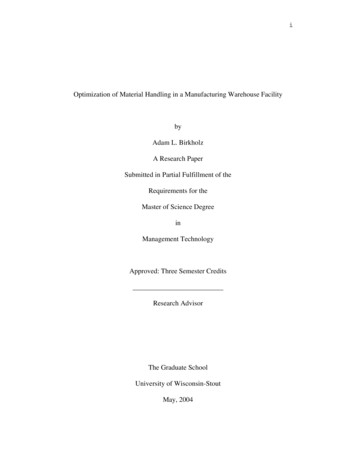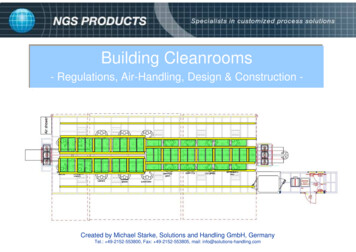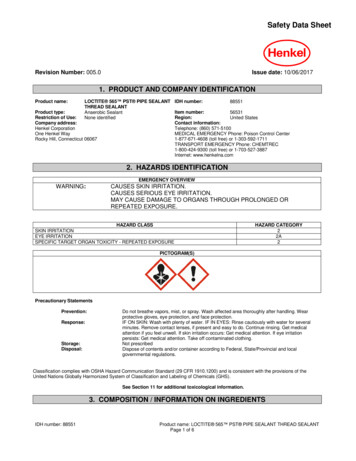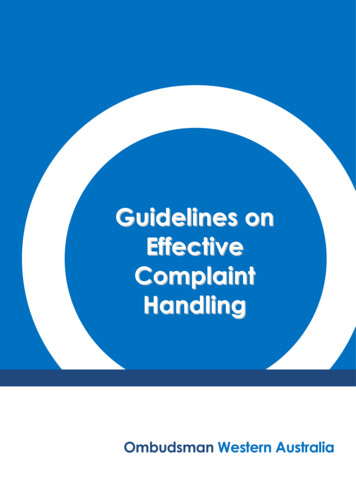
Transcription
Guidelines onEffectiveComplaintHandlingOmbudsman Western Australia
ContentsGuidelines on Complaint Handling: Effective handling of complaints made to your organisation The principles of effective complaint handling Making your complaint handling system accessible Complaint Handling Systems Checklist Guidance for Complaint Handling Officers Investigation of complaints Procedural fairness (natural justice) Remedies and redress Dealing with unreasonable complainant conduct Good record keepingOmbudsman Western AustraliaLevel 2 Albert Facey House, 469 Wellington Street Perth WA 6000 PO Box Z5386 St Georges Terrace Perth WA 6831Tel 08 9220 7555 Freecall (outside metropolitan area) 1800 117 000 Fax 08 9220 7500Email mail@ombudsman.wa.gov.au Website www.ombudsman.wa.gov.au
Ombudsman Western AustraliaGUIDELINESEffective handling of complaintsmade to your organisation - An OverviewRevisedSeptember 2020Benefits of good complaint handlingComplaints are an important way for the management of an organisation to be accountable to the public, aswell as providing valuable prompts to review organisational performance and the conduct of people that workwithin and for it.A complaint is an “expression of dissatisfaction made to or about an organisation, related to its products,services, staff or the handling of a complaint, where a response or resolution is explicitly or implicitly expectedor legally required” 1. As a matter of guidance, complaints can be made directly to an organisation bymembers of the public and/or customers, or through alternative pathways such as to Members of Parliamentor statutory officers but otherwise about the organisation.Effective complaint handlingisfundamentaltotheprovision of a quality service.An effective complaint handling system provides three key benefits toan organisation: It resolves issues raised by a person who is dissatisfied in a timelyand cost-effective way; It provides information that can lead to improvements in service delivery; and Where complaints are handled properly, a good system can improve the reputation of an organisation andstrengthen public confidence in an organisation’s administrative processes.The public wants:The organisation needs: a user friendly complaint handling system a user friendly system for accepting feedback to be heard and understood to be respectedclear delegations & procedures for staff to dealwith complaints and provide remedies an explanation a recording system to capture complaint data an apology action as soon as possibleto use complaint data to identify problems andtrends to improve service delivery in identified areasEffective complaint handling systemsSTEP 1 ENABLING COMPLAINTS ArrangementsSTEP 2 - RESPONDINGTO COMPLAINTSSTEP 3 - ACCOUNTABILITYAND LEARNINGfor enabling Complaints are responded topeople to make complaintspromptly and handled objectively,are customer focused, visible,fairly and confidentially. Remediesare provided where complaints areaccessible and valued andsupported by management.upheld and there is a system forreview.1 Thereareclearaccountabilities for complainthandling and complaints areusedtostimulateorganisationalimprovements.See Australian/New Zealand Standard AS/NZS 10002:2014 Guidelines for Complaint Management in Organizations (as amended)at www.standards.com.au.
Effective handling of complaintsRevised January 2017Ten Principles for an Effective Complaint Handling SystemEnabling complaintsHaving a customer focused system that is visible and accessible, with a demonstrated commitmentfrom the organisation’s rinciple: The organisation is committed to effective complaint handling andvalues feedback through complaints. Organisations should be open to feedback and committed to seekingappropriate resolution of complaints and addressing policy and processinadequacies highlighted by them. This commitment should be communicatedto all staff, stakeholders and clients, for example through documents such asvalues statements or customer service standards. Organisations should have a clearly communicated complaint handling processand management that values the benefits of an effective complaint handlingsystem and supports the process.Principle: Information about how and where to complain is well publicised tocustomers, staff and other interested parties. Information about how and where to complain should be well publicisedthrough a variety of service delivery points including publications, websites, atoffices and at front counters. Front-line staff should be aware of the complaint handling process and thecontact details of the organisation’s Complaint Handling Officer(s). The information about how to complain should identify any appropriatealternative external parties the complainant can go to with their complaint.Principle: The process of making a complaint and investigating it is easy forcomplainants to access and understand. Complaints should be handled at no charge and this should be made clear ininformation provided about the complaint handling process. Information about the complaints process should be available in a variety offorms of communication, formats and languages appropriate to the needs ofthe customer. Complaints and all supporting documents provided during a complaintresolution or investigation process should be accepted in a number of differentways including in person, over the phone, and in writing via email, fax andletter, and, where appropriate, access to translating and interpreting servicesfor non-English speaking people should be provided. Complaint handling systems should be accessible to members of the publicwho may require additional assistance such as Indigenous Australians,children and young people, people living in regional and remote areas, peoplewith disabilities and people from culturally and linguistically diversebackgrounds.For more information, see the Ombudsman WA Guidelines Making yourcomplaint handling system accessible.Ombudsman Western Australia
Effective handling of complaintsRevised January 2017Responding to complaintsComplaints are handled objectively and fairly with appropriate confidentiality, remedies are providedwhere complaints are upheld and there is a system for review for finalised complaints.ResponsivenessObjectivity andfairnessPrinciple: Complaints are acknowledged in a timely manner, addressedpromptly and according to order of urgency, and the complainant is keptinformed throughout the process. Guidance should be provided to staff on how to respond to and prioritisecomplaints. They should be aware of internal complaint handling processesincluding how to assess complaints which may be resolved quickly and thosewhich require investigation. Complaints should be acknowledged promptly. Complainants and, ifapplicable, the person who is the subject of the complaint, should be keptinformed of progress and the outcome of the complaint. Complaints should be addressed promptly in order of urgency and staff shouldbe aware of any target timelines for resolving complaints. Complaint Handling Officers should be empowered to either resolve complaintsor be aware of, and have access to, the person who has the authority to do so. Where appropriate, special arrangements for responding to particular clientgroups should be put in place, for example, Indigenous Australians, childrenand young people, people living in regional and remote areas, people withdisabilities and people from culturally and linguistically diverse backgrounds. Staff should be able to identify matters that may be public interest disclosuresand refer them to the appropriate process, and should refer any identifiedmisconduct and corrupt behaviour to the Corruption and Crime Commission(www.ccc.wa.gov.au) for serious misconduct or the Public SectorCommission (www.publicsector.wa.gov.au) for minor misconduct 2.Principle: Complaints are dealt with in an equitable, objective and unbiasedmanner. This will help to ensure that the complaint handling process is fairand reasonable. Unreasonable complainant conduct is not allowed tobecome a burden. Complaint Handling Officers should deal with all complaints on their merit in anequitable, objective and unbiased manner. They must ensure that any conflictsof interest are declared. Complaint Handling Officers should ensure the complainant and, if applicable,the person who is the subject of the complaint, is given sufficient opportunity topresent their position, to comment on any adverse findings and is provided withreasons for decisions on the outcome of the complaint. Complaint handling systems should have a review process in which theComplaint Handling Officer’s decision is reviewed by a suitably experiencedcolleague or superior before the complaint is finalised. There should also be anindependent internal review or appeal process. Officers receiving and handling complaints should receive appropriateguidance or training, including for dealing with unreasonable conduct by thecomplainant or the subject of the complaint.The Ombudsman WA publications Conducting administrative investigations,Investigation of complaints, Procedural fairness and Dealing withunreasonable complainant conduct may assist your staff in handling complaintswith objectivity and fairness.2See Corruption, Crime and Misconduct Act 2003 at www.slp.wa.gov.au/legislation/statutes.nsf/main mrtitle 207 homepage.htmlOmbudsman Western Australia
Effective handling of complaintsConfidentialityPrinciple: Personal information related to complaints is kept confidential. RemedyReviewRevised January 2017The personal information of the complainant and any people who are thesubject of a complaint should be kept confidential and only used for thepurposes of addressing the complaint and any follow up actions.Principle: If a complaint is upheld, the organisation provides a remedy. Mechanisms should exist for enabling appropriate remedies to be providedwhen complaints are upheld and staff should be familiar with them. Staff shouldbe able to give the complainant reasons for decisions relating to remedies. Staff should be empowered to provide these remedies at the appropriate level,for example some appropriate remedies may be provided by front-line staff.Principle: There are opportunities for internal and external review and/orappeal about the organisation’s response to the complaint, and thecomplainants are informed about these avenues. There should be an independent internal review or appeal process. Details of external rights of review or appeal for unresolved complaints shouldbe made available to complainants.Accountability and LearningThere are clearly established accountabilities for complaint handling and continuous improvementopportunities are identified and implemented, as appropriate.AccountabilityPrinciple: Accountabilities for complaint handling are clearly established,and complaints and responses to them are monitored and reported tomanagement and other stakeholders. There should be clear responsibilities for handling complaints. This mayinclude officers who are specifically assigned to deal with complaints and thenames of these officers should be communicated to staff. Organisations should have a ‘fit for purpose’ centralised system for recordingand tracking complaints along with reasons for any decisions. This systemshould be able to provide information on the demographic make up ofcomplainants to enable an assessment of differing service delivery needs forpeople from a range of backgrounds. Complaints can be made directly to anorganisation by members of the public and/or customers, or through alternativepathways such as to Members of Parliament or statutory officers but otherwiseabout the organisation. Complaints and actual or proposed improvements to practices should form partof the organisation’s internal reporting and planning process through suchchannels as Corporate Executive meetings and Strategic and OperationalPlans. Remedies and proposed improvements to practices should be followed up andacted on. All correspondence relating to feedback and complaints should be managed inaccordance with the organisation’s record keeping plan, policies andprocedures. For more information, see the Ombudsman WA Guidelines Goodrecord keeping. The effectiveness of the complaint handling system should be monitored, forexample, through quality assurance or internal audit processes and reported toCorporate Executive along with recommendations for system improvements.Ombudsman Western Australia
Effective handling of complaintsContinuousImprovementRevised January 2017Principle: Complaints are a source of improvement for organisations. Organisations should analyse complaints data and feedback to identifyrecurrent themes that might identify systemic issues and use the informationgathered through their complaint handling systems to identify service, processand information issues that need to be addressed. Where appropriate, analysis of feedback and complaint information should beused to identify and implement improved practices for particular customergroups including people with disabilities, people living in regional and remoteareas, Indigenous Australians, children and young people, and people fromlinguistically and culturally diverse backgrounds.Organisations may find the Ombudsman WA publication Complaint handling systems Checklistuseful to assess their complaint handling system.Fit for purpose complaint handling systemAn effective complaint handling system should be a ‘fit for purpose’ system. This is a system that isvaried to fit an organisation’s circumstances and is proportionate to the number and type of complaintsit receives. Decisions about building a ‘fit for purpose’ system could incorporate the followingconsiderations: The number and demographics of the organisation’s customers, and how they generallycommunicate with the organisation; The nature and breadth of the organisation’s interactions with the public; The level of complaints that is considered reasonable for the organisation (by examining trends inits level of complaints over time and industry benchmarks); The organisation’s risk management strategy – complaints are an important way of monitoring andmitigating any risks; The value the organisation derives, or wishes toderive, from complaints to improve it’s operations overtime, as well as other information needs ofmanagement; and The cost of operating a complaint handling system.Complaint Handling OfficersComplainants are more likely to besatisfiedwiththecomplainthandling system if the persondealing with their complaint iscompetent, objective and efficient.Complaint handling is an important role in an organisation and should be recognised as such bymanagement. Complaint Handling Officers are the most important factor in ensuring that anorganisation’s complaint handling is responsive to complainants. Complaint Handling Officers should beempowered to make decisions, or have access to someone who can make decisions.An effective resolution at the earliest opportunity will enhance the complainant’s view of theorganisation and allow prompt improvement to practices. Complaints should be handled by people whohave the appropriate skills and authority to resolve or investigate complaints and, where appropriate,provide remedies and identify improved practices.Where possible, complaints are best handled by people at the point of service delivery. These peopleshould be able to resolve complaints at first contact and should log complaint details for furtheranalysis. More serious complaints, or complaints that cannot be resolved by front-line staff, should bereferred to more senior staff or designated Complaint Handling Officers for investigation, resolution andany other appropriate action.All staff should be made aware of their responsibilities in providing information to help investigate andresolve complaints, and to implement actions to provide remedies or systemic improvements arisingfrom complaints. For more information see the Ombudsman WA Guidelines Guidance for ComplaintHandling Officers.Ombudsman Western Australia
Effective handling of complaintsRevised January 2017Complaints investigation and resolution processComplaints should be dealt with promptly, courteously and in accordance with their urgency. Theessential steps in investigating and resolving a complaint are:1. Assess thecomplaintClarify the issues of the complaint and what kind of resolution thecomplainant is seeking. If it is not a matter that can be handled by thecomplaints process, refer the complainant to a more appropriate process(e.g. an appeal process) or a more appropriate body such as theOmbudsman. For example, consider whether the matter is a public interestdisclosure and should be handled under that process.2. Seek resolutionWhere appropriate and possible seek to achieve resolution. Whereresolution is reached, document the agreed action. In this event it may not benecessary to continue with the investigation unless there are systemic issuesthat require further examination outside the complaint process.3. Select theappropriateinvestigativeapproachIf the complaint is not resolved, determine what action is required, which mayinclude options other than a formal investigation. This can depend on factorssuch as statutory requirements which may apply, the nature of the issue andthe likely outcome of the investigation. Where possible, complaints should beresolved without the need for a formal investigation.4. Plan theinvestigationDefine the issues to be investigated and develop an investigation plan.5. Ensure properpowers andauthorityAssess whether the Complaint Handling Officer has the necessary powers toobtain evidence from relevant witnesses and to access relevant records.Ensure they have the authority to conduct the investigation, make a decisionand resolve the complaint, or have access to a person who can makedecisions and offer remedies.6. Obtain evidenceCarry out the investigation by gathering sufficient reliable information toenable the issue to be properly addressed by proving or disproving mattersrelevant to the issue being investigated, taking into account all relevantinformation and no irrelevant information. At this stage, it may be necessaryto refer any matters that may be misconduct or corruption to the Corruptionand Crime Commission.7. ReconsiderresolutionConsider whether resolution is now possible.8. Reporting andrecommendationsPrepare a document setting out the complaint, how the investigation wasconducted, relevant facts, conclusions, findings and recommendations.Recommendations could include remedies for the complainant, action toimprove the organisation’s service delivery and action to addressinappropriate conduct by an officer (e.g. through training, an appropriatedisciplinary process or referral to an appropriate external authority).9. Decide on thecomplaint andaction to betakenRefer the report to a person authorised to make a decision about thecomplaint and the action to be taken. After the decision is made arrangeimplementation of the agreed action and for follow up to confirm the actionoccurs.10. Inform the partiesUpon completion of an investigation, the complainant (and, if applicable, theperson who is the subject of the complaint) should be given: Adequate reasons for any decision made; Any changes or action that have resulted from the complaint; A remedy, where appropriate; and Information on where to seek independent internal and external review(e.g. the Ombudsman).For more information see the Ombudsman WA Guidelines Investigation of complaints andConducting administrative investigations which provide more detailed ‘step-by-step’ guidance.Ombudsman Western Australia
Effective handling of complaintsRevised January 2017Providing remedies and redressIf an investigation of a complaint determines that the service provided by an organisation to anindividual is unsatisfactory and the organisation has in some way contributed to this, the organisationshould provide redress to remedy the situation.Circumstances that warrant the provision of redress and remedies by an organisation to a complainantcan arise in many ways, but in broad terms, are when any one, or a combination, of the followingoccurred: Poor communication resulted in misunderstandings or misapprehensions; An inadequate or unfair process was used to arrive at a decision or provide a service; or A decision or action was unfair, disproportionate or unreasonable in the circumstances.The following principles and possible remedies may be useful in determining appropriate remedies:Principles involved inthe consideration ofredress Possible remedies thatmay be offered tocomplainants Mistakes are admitted and put right;A sincere and meaningful apology is offered;Redress is fair and reasonable;As far as possible, redress restores the complainant to their originalposition;Decisions about redress are procedurally sound; andArrangements and reasons for providing redress are madetransparent.An apology;Reconsideration of a decision;Amending or retracting documentation (e.g. publications, mediastatements, web pages);An offer of non-financial assistance, as appropriate (e.g. providinginformation or contact details);Appropriate compensation for loss;Changed policies or practices to prevent a reoccurrence; andAction to modify the behaviour of the staff member who thecomplaint was about, if applicable.For more information, see the Ombudsman WA Guidelines Remedies and redress.Dealing with unreasonable complainant conductMost complainants act responsibly. However, some complainants are difficult to satisfy andoccasionally the conduct of some complainants can be challenging because of: Unreasonable persistence; Unreasonable arguments; Unreasonable demands; Unreasonable behaviour; or Unreasonable lack of cooperation.In these circumstances, special measures to deal with this conduct may be required. It is important toremember that, even where a person’s conduct may be unreasonable, they may have a valid complaintand their complaint should be handled appropriately. Fair consideration must be given to the complaintwhile ensuring that there is not undue use of resources to investigate and resolve the complaint.The subject of the complaint may also show unreasonable conduct and special measures may also beneeded to handle their conduct while ensuring they are treated fairly.For more information on how to handle unreasonable conduct, see the Ombudsman WA GuidelinesDealing with unreasonable complainant conduct.Ombudsman Western Australia
Effective handling of complaintsRevised January 2017ResourcesOther Ombudsman Western Australia availableonourwebsiteatwww.ombudsman.wa.gov.au and provide further details that may be useful in the development ofcomplaint handling systems and for staff involved in handling complaints: Guidance for Complaint Handling Officers Complaint handling systems Checklist Making your complaint handling system accessible The principles of effective complaint handling Investigation of complaints Conducting administrative investigations Procedural fairness Dealing with unreasonable complainant conduct Remedies and redress Good record keepingThe Ombudsman's Report 2009-10 Survey of Complaint Handling Practices in the WesternAustralian State and Local Government Sectors also provides further information on complainthandling practices in public authorities.Ombudsman Western AustraliaPO Box Z5386 St Georges Terrace Perth WA 6831Phone 08 9220 7555 Freecall (free from landlines) 1800 117 000 Fax 08 9220 7500 Interpreter 131 450National Relay Service Quote 08 9220 7555 TTY 133 677 Voice-only (speak and listen) 1300 555 727 SMS Relay Text 0423 677 767Email mail@ombudsman.wa.gov.au Website www.ombudsman.wa.gov.au
Ombudsman Western Australia Responds promptly and effectively to complaints - complaints are handledobjectively and fairly with appropriate confidentiality, remedies are provided wherecomplaints are upheld and there is a system for review for finalised complaints;and Provides for accountability and learning - there are clearly establishedaccountabilities for complaint handling and continuous improvement opportunitiesare identified and implemented, as appropriate.The principles of effective complaint handling1. Customer focus – the organisation is committed to effective complaints handlingand values feedback through complaints.VisibilityEnables complaints to be made - a customer focused system, that is visible andaccessible, with a demonstrated commitment from the organisation’smanagement;Accessibility Step 1:EnablingComplaintsStep 2:Responding toComplaintsObjectivity& fairnessThe key features of an effective complaint handling system can be organisedaccording to 10 principles for good practice. These principles form the three stages ofcomplaint handling:November 2010Customer focusThe principles of effective complaint handlingResponsivenessGUIDELINES2. Visibility – information about how and where to complain is well publicised tocustomers, staff and other interested parties.Confidentiality3. Accessibility – the process for making a complaint and investigating it is easy forcomplainants to access and understand.4. Responsiveness – complaints are acknowledged promptly, addressed accordingto urgency, and the complainant is kept informed throughout the process.Remedy5. Objectivity and fairness – complaints are dealt with in an equitable, objectiveand unbiased manner. This will help ensure that the complaint handling processis fair and reasonable. Unreasonable complainants are not allowed to become aburden.8. Review – there are opportunities for internal and external review and/or appealabout the organisation’s response to the complaint, and complainants areinformed about these avenues.9. Accountability – accountabilities for complaint handling are clearly established,and complaints and responses to them are monitored and reported tomanagement and other stakeholders.10. Continuous Improvement – complaints are a source of improvement fororganisations.Ombudsman Western AustraliaStep 3:Accountabilityand LearningContinuousimprovement7. Remedy – if a complaint is upheld, the organisation provides a remedy.AccountabilityReview6. Confidentiality – personal information related to complaints is kept confidential.PO Box Z5386 St Georges Terrace Perth WA 6831Phone 08 9220 7555 Freecall (free from landlines) 1800 117 000 Fax 08 9220 7500 Interpreter 131 450National Relay Service Quote 08 9220 7555 TTY 133 677 Voice-only (speak and listen) 1300 555 727 SMS Relay Text 0423 677 767Email mail@ombudsman.wa.gov.au Website www.ombudsman.wa.gov.au
Ombudsman Western AustraliaGUIDELINESMaking your complaint handlingsystem accessibleRevisedNovember 2010Accessible complaint processesThe process for making a complaint and investigating it should be easy to access and understand. Informationabout the process should be available in a variety of forms of communications, formats and languagesappropriate to the needs of all members of the diverse Western Australian community.Receiving complaintsComplaints and related correspondence during an investigation should be accepted in a number of differentways including in person, over the phone, and in writing via email, fax and letter. Access should be provided totranslating and interpreting services for non-English speaking people to assist them to make a complaint.Complainants who require additional assistanceOrganisations should pay particular attention to ensuring that their complaint handling system is accessible tomembers of the public that may require additional assistance or different approaches such as people withdisabilities, people living in regional and remote areas, Indigenous Australians, children and young people, andpeople from linguistically and culturally diverse backgrounds. Organisations should consider taking thefollowing actions:IndigenousAustraliansPeople withdisabilitiesPeople inregional andremote areas If your organisation has high numbers of Indigenous clients, appoint anIndigenous liaison officer to improve access to your organisation’s services andcomplaint handling systems. Identify people in regional and remote locations who can assist with culturalcommunications. Provide training for complaint handling officers in cultural awareness and crosscultural communications. Adapt your complaint handling process to meet cultural requirements ofIndigenous people such as less formal meeting arrangements and be aware thatcommunication with remote areas may take longer. Accept complaints from representatives and translation services on behalf of nonEnglish speaking Indigenous complainants. Provide a text telephone (TTY) service for people with a hearing impairment. Make websites accessible to people using screen readers and, if necessary,make publications and correspondence available in Braille, large print or audioformats for people with sight impairment. Ensure offices are accessible to wheelchairs and to people with mobilityimpairment. Ask people if they have any special requirements for access or communications. Offer assistance to help complainants with reading or writing difficulties toformulate and lodge complaints. Accept complaints on behalf of people with intellectual impairment fromrepresentatives. Provide a toll-free phone number for making phone enquiries and complaintsfrom regional areas. Provide hard copy information such as brochures and posters in areas withlimited online access. Be aware that communication with remote areas may take longer.
Making your complaint handling system accessibleChildren andyoung peoplePeople fromlinguisticallyand culturallydiversebackgroundsRevised November 2010 Make information about your organisation’s services and how to providefeedback/make
Ombudsman Western Australia Level 2 Albert Facey House, 469 Wellington Street Perth WA 6000 PO Box Z5386 St Georges Terrace Perth WA 6831 Tel 08 9220 7555 Freecall (outside metropolitan area) 1800 117 000 Fax 08 9220 7500
